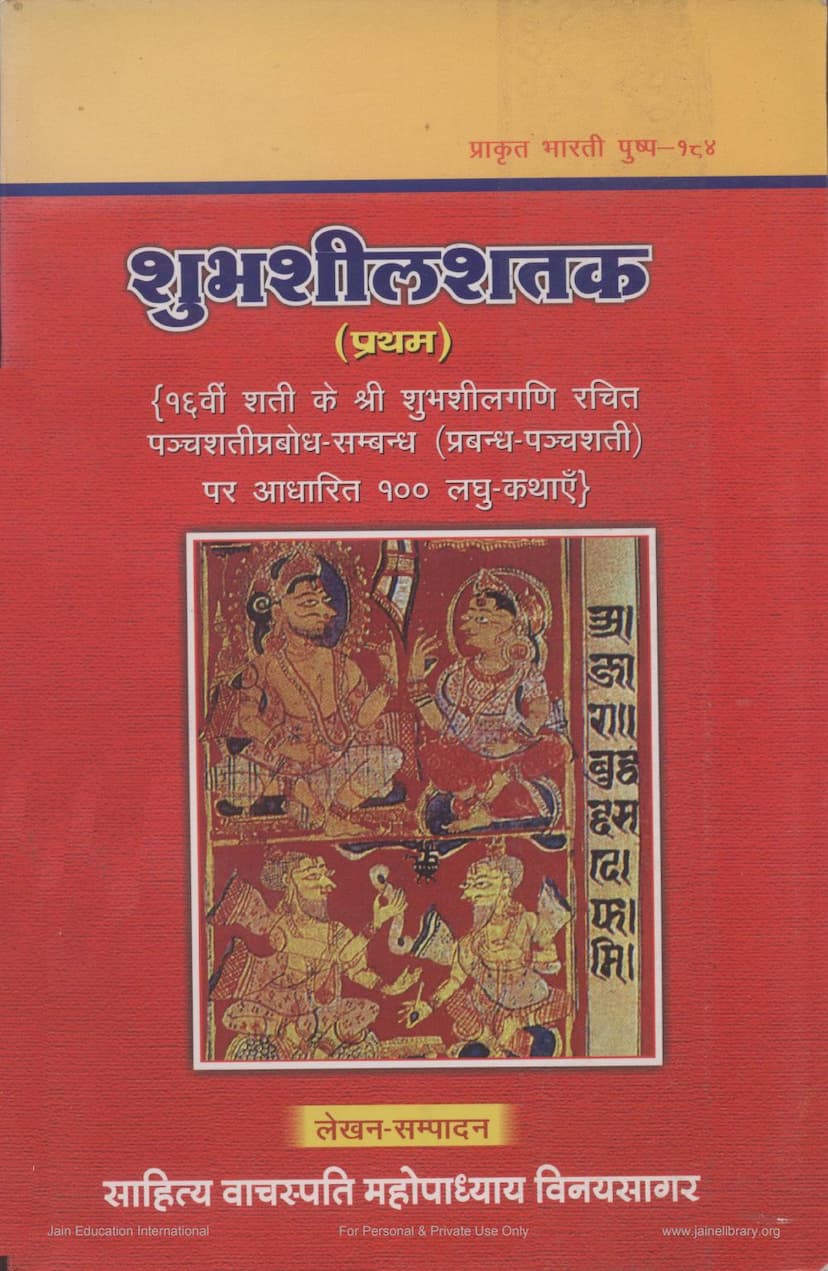Shubhshil Shatak
Added to library: September 2, 2025

Summary
Here's a comprehensive summary of the Jain text "Shubhshil Shatak" by Vinaysagar, based on the provided pages:
Book Title: Shubhshil Shatak (First Part) Author: Vinaysagar Publisher: Prakrit Bharti Academy, Jaipur Original Source: Based on the first 100 short stories from the "Panchashati Prabodh Sambandh" (also known as "Prabandh Panchashati") composed by Shri Shubhshilgani in the 16th century.
Overview:
"Shubhshil Shatak" is a collection of 100 short stories compiled and translated into Hindi by Mahopadhyaya Vinaysagar. These stories are drawn from the original work "Panchashati Prabodh Sambandh" by Shri Shubhshilgani, a prominent Jain scholar from the 15th-16th century. The book aims to present moral principles and life values in an engaging and accessible manner through captivating narratives, following a long-standing tradition in Indian literature where stories serve as powerful vehicles for spiritual, philosophical, and ethical teachings.
Content and Themes:
The "Shubhshil Shatak" presents a diverse range of stories that highlight various aspects of Jain philosophy and practical life, including:
- Moral and Ethical Teachings: Many stories illustrate virtues like truthfulness, integrity, compassion, generosity, and the consequences of vice.
- Wisdom and Intelligence: The narratives often showcase cleverness, foresight, and the importance of righteous conduct in navigating challenges.
- The Power of Devotion and Faith: Stories emphasize the benefits of devotion to Jain Tirthankaras and adherence to religious practices.
- The Consequences of Actions (Karma): The interconnectedness of actions and their future outcomes is a recurring theme, demonstrating the principle of karma.
- The Importance of Righteous Conduct: The narratives underscore the significance of adhering to dharma in personal and social life.
- The Role of Gurus and Spiritual Guidance: The stories often feature Jain acharyas and their teachings, highlighting the importance of spiritual guidance.
- Historical and Social Context: Some stories provide glimpses into the societal norms, customs, and prominent figures of the time, including Jain ministers, merchants, kings, and even folk tales.
- Examples of Renunciation and Spiritual Attainment: The text includes narratives of individuals who achieved spiritual liberation through their dedication and practices.
- The Cleverness and Wit of Individuals: Several stories showcase the intelligence and quick thinking of characters in overcoming difficult situations.
Author and Translator:
- Shri Shubhshilgani (Original Author): A prolific Jain scholar who lived in the 15th-16th century, known for his extensive works in Jain literature, grammar, and lexicography. He was a disciple of various esteemed acharyas, all belonging to the lineage of Acharya Shri Somasundarsuri. His "Panchashati Prabodh Sambandh" was composed in Vikram Samvat 1521. His writings, while scholarly, aimed for accessible language.
- Mahopadhyaya Vinaysagar (Compiler/Translator): A highly respected scholar and the Honorary Director of Prakrit Bharti Academy, Jaipur. He has undertaken the task of translating and adapting the original Sanskrit stories into Hindi in his distinctive style, while retaining the essence and inspiration of the original work. He has also modified the titles of the stories to be more contemporary.
Structure and Publication:
"Shubhshil Shatak" is presented as the first volume of a larger series, with five more volumes planned. The book is published by Prakrit Bharti Academy, Jaipur, with the first edition released in 2005. The book's preface and introduction discuss the importance of storytelling in conveying moral and ethical values and express gratitude to Mahopadhyaya Vinaysagar for his efforts.
Key Stories and Examples (from the provided table of contents and sample pages):
The table of contents lists 100 stories with intriguing titles, covering a wide array of subjects. Some of the highlighted stories from the sample pages include:
- "Mere Dikshit Shishya Kevalgyani Aur Main?" (My Ordained Disciple, Omniscient, and I?): This story likely deals with a situation involving Gautam Swami and his disciples' spiritual progress, highlighting the nature of omniscience and spiritual realization.
- "Mulla Ki Topi Ko Akash Se Utarna" (Pulling the Mulla's Cap Down from the Sky): This story appears to involve a miraculous event, possibly related to the powers of Jain acharyas, possibly Jinprabh Suri, and their interactions with the Sultan (likely Muhammad bin Tughluq).
- "Shukra Kis Mein Meethi Lagti Hai?" (In What Does Sugar Taste Sweet?): This likely features a philosophical or practical riddle posed to a king or sultan, answered by a wise individual.
- "Jagdish Seth Ka Grih-Chaitya Teerth Ke Saman Hai" (Seth Jagat Singh's Home Shrine is Like a Pilgrimage Site): This story probably emphasizes the importance of devotion and the sacredness of even domestic religious spaces.
- "Dhanyabal Se Samriddhi Swayam Prapt Hoti Hai" (Prosperity Comes Automatically by the Power of Merit): This story likely illustrates how good deeds lead to inherent prosperity and good fortune.
- "Vyapar Hi Jati-Bodhak Hota Hai" (Business Itself is the Indicator of Lineage): This story might explore how one's profession or business dealings can reflect their character and background.
- "Ahimsa Ki Mahatta" (The Greatness of Non-Violence): This story would focus on the importance and impact of practicing ahimsa.
- "Nari Ka Buddhi Chatura" (A Woman's Intellectual Dexterity): This highlights the intelligence and resourcefulness of women in overcoming challenges.
Overall Purpose:
The "Shubhshil Shatak" aims to educate and inspire readers by presenting timeless values and ethical principles through engaging narratives. It serves as a valuable resource for those seeking moral guidance, spiritual upliftment, and a deeper understanding of Jain traditions and wisdom, making complex teachings accessible through the art of storytelling.